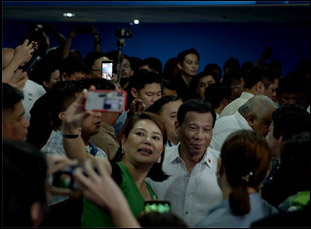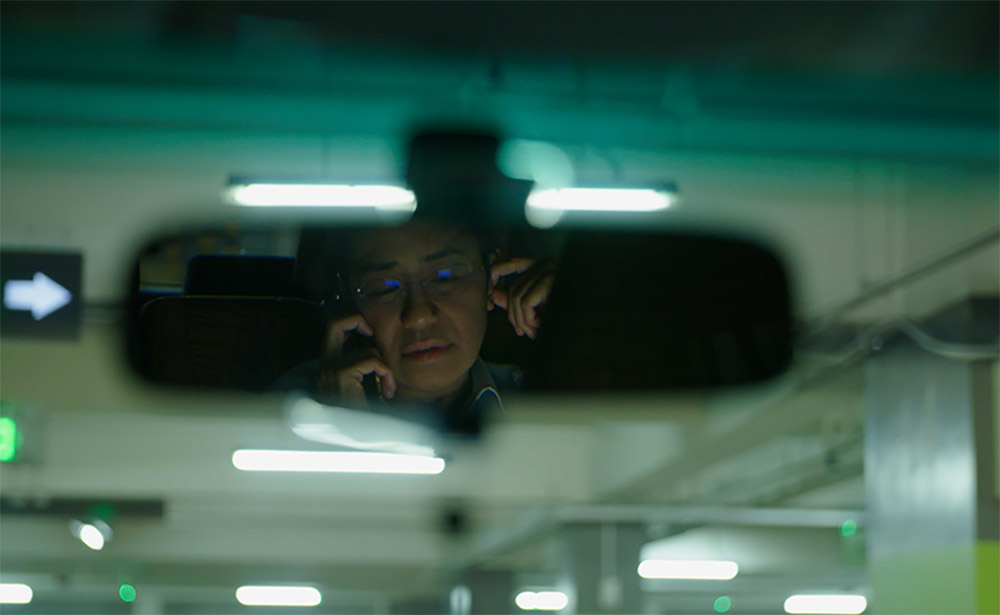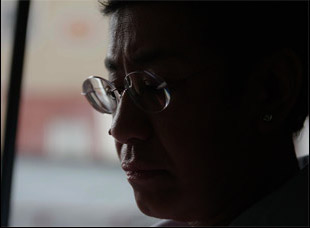Even if Ramona Diaz hadn’t thought of herself in the same vein of the hard-charging reporter Maria Ressa, the subject of her latest film “A Thousand Cuts,” she’s gotten even more of an insight into her world than when they spent time together over the course of the 2019 midterm elections in the Philippines as as Ressa has faced ongoing prosecution from President Rodrigo Duterte’s regime as a way of silencing her outlet Rappler.
“I’ve never done breaking news, so it’s interesting to fight with news outlets,” says Diaz, who has had to update the end credits a few times both leading up to and after the film’s triumphant premiere at the Sundance Film Festival earlier this year. “That’s what they do. They know how to do this and I’m like, ‘Oh my God, I just stay and stay and stay until everyone leaves and I’m the last one in the room.’”
That persistence has yielded a form of justice for Ressa — and for the cause of journalism in general — that she has not been afforded in the courts, where the veteran reporter was found guilty of cyber-libel in June on specious charges (even without going into the particulars, the situation in question happened before laws were even in place for it to be illegal). If “A Thousand Cuts” proved to be a new experience for the filmmaker, it still fits in well into her body of work, celebrating the strength and resiliency of Filipinos while articulating the often unnecessary hardship that cultivates such grit with films including “Don’t Stop Believin’: Everyman’s Journey,” detailing the improbable rise of Arnel Pineda to become frontman for Journey, and “Motherland,” which allowed audiences to see grace under pressure amidst the frenzy of the country’s overmatched maternity wards.
With Ressa, the filmmaker finds that reporting the facts has become a crime under President Duterte’s watch where countless murders happen every day under the cover of his war on drugs, which has been deployed to artificially lower the nation’s devastating poverty rate and execute political opponents. But as Diaz shows, his attack isn’t only on the streets, but on the internet — an equally important sphere in a country that spends more time online than any other in the world at 10 hours a day, on average — where the distinction between actual reportage and baseless accusations can be easily blurred and a force of personality with a fervent following, no matter how small it is, such as Duterte can whip up supporters to strike fear into the hearts of those who stand against them.
As terrifying as it is to see the Duterte regime attempt to make an example out of Ressa, “A Thousand Cuts” becomes galvanizing in showing how she and other journalists at Rappler such as Patricia Evangelista and Pia Ranada remain undaunted as they cover the midterms, which as no shortage of intriguing candidates such as General Bato De La Rosa and social media star Mocha Uson who hope to ride the President’s coattails to office by taking his bombastic approach to campaigning. Diaz finds an election with ramifications that ripple far beyond the borders of the Philippines and with the film arriving in virtual cinemas before the U.S. presidential election cycle which is bound to be rife with the same issues, the filmmaker spoke about becoming conscious of how perniciously disinformation travels, covering a sprawling campaign and Ressa’s impressively long memory.
When Duterte became president in 2016, I knew I wanted to do something in the Philippines under Duterte because it seemed like martial law and I’m a marital law baby. I grew up under the Marcos’ dictatorship, so I was afraid that something amiss was happening again. I was finishing “Motherland” when he became president and when he started the drug war, you start seeing pictures and I couldn’t avert my gaze. I had to see. So I went to the Philippines and I realized that there were so many filmmakers and news [outlets] covering the drug war there, I said something else must be happening. And of course, Maria Ressa was happening, right? She was not only calling out the drug war and all kinds of impunity and abuses the administration was doing, but she was also talking about disinformation and connecting that to drug war impunity.
She was one of the first to talk about algorithms and Facebook and fake news and putting all that together in a very cogent way that I’d never heard before. It blew me away because I knew about those things, but to unwrap it in that manner makes you think more [because] disinformation makes it a more global story. So you ask for access [to Maria] and then you ask again and again and again. [laughs] Until they say yes — I always say I would never say yes to me, because what I want to be is in your life for a long time. [laughs] But we became friends and she trusted the process and gave me access to a lot of things, so I was very thankful.
You told this great story as part of the AFI Docs screening about how you actually turned down talking to Maria when she was a correspondent for CNN when were doing the rounds for “Imelda,” your film on Imelda Marcos, because she wanted to speak to you more about the fallout than the film itself. Was that an interesting way to start a relationship?
It’s interesting to hear you talk about your own personal experience because I thought you surely might be able to relate to Maria’s predicament to the extent that it might be getting harder to film in the Philippines, given the attitude towards the press and your reputation at exposing these things.
You would think, but really, it gives me more access actually. The president knew I was making this film because I spoke to his spokesperson because we wanted to be close to him at those rallies. We wanted to be in the pit. We didn’t want to be in the media box and that took really special permission, and then of course I was filming General Baton and Mocha Uson, who were both part of his administration then, so they were very aware I was making this film. I think their awareness, the fact that I was so present and so visible, protected me. If I had done it under the radar, I wouldn’t have felt as secure.
Obviously, we were also filming Maria and every time she got arrested, you could see us on television because we were following her, so they were well aware we were following her and vice versa — Maria knew I was following Mocha and Baton — so to be really transparent for me is key. They know of my past work, but they also understand that I speak to an audience beyond the Phillippines because although I make my films there, I produce it here for this audience, so they wanted to be part of that.

I had two units on the ground constantly, and when I decided that the midterm elections was going to be the backdrop of the film, I was still thinking in my head that it was going to be an ensemble of characters – very Robert Altman-esque. But a few days after campaigning began, [Maria] got arrested, so her life became parallel with the midterm elections and you couldn’t write that kind of stuff. Five weeks later, she got arrested again and at some point, she became the center of gravity for the film, but I had one unit on her exclusively and then the other unit still following Mocha and Baton wherever they were because I thought the campaign itself gave a lot of local color and context to the story. It’s a global story of authoritarianism, but still rooted in specificity in the Philippines and local elections, and elections there are very kinetic and cinematic. It’s all a spectacle, so I thought it was good.
So much of the story takes place on social media and online, which typically aren’t very cinematic, but become so here. Were you conscious of how you’d weave that element into the film while you were filming?
Yeah, I knew somehow we had to use real exciting graphics, if graphics can be exciting, right? But graphics are organic to the film, so if you notice, the colors of the graphics are the same colors as the headlines of Rappler, and we made it all integrated. But my other films don’t have graphics, [and we needed it] in order to unwrap what it is [Maria] talks about because she talks about this information not in terms of content — because if you go after content, it’s a whack-a-mole game. You’ll never get on top of it — but if you look at systems and networks, you can actually see how disinformation just spreads like wildfire. We had to make that visual. The way she unwrapped it for me, I knew I had to unwrap it for an audience, so we just got what was in her head and tried to make it as cinematic as possible. It’s key that people understand how this thing works and how under attack she’s been for four years [with this] crazy gendered misogynistic trolling.
One of the other interesting elements of how you structure the film is when you’ll go back to this 2015 interview she does with Duterte, which you not only use for context, but it becomes more and more improbable that they were once speaking to one another in a civil fashion. How did you want to incorporate that into the film?
Oh my God, that’s part of Rappler archives because we started after that [happened], and I couldn’t believe that she interviewed him twice. They were very friendly because it was before all the animosity began and in my head, [I’m thinking] we’ve just got to keep going back to it to remind them that this is a relationship between a journalist and a president. It isn’t political opposites. I think that reminds people that this is the role of journalists to question power and she questions him really well while still being respectful. She says, “You broke the law, Mr. President. Now you’re the president and you have to make sure people don’t break the law. How are you going to reconcile that?” She says that in such a still respectful way, but is telling him, you’ve already broken the law, so what are you going to do about it?” and it became very clear that that has to be a through line you keep going back to.
The film has some wonderful cinematography, particularly how you’ll have Maria in the foreground of some shots and you get a strong sense of what she’s up against by how the background will loom large over her – there’s a particularly stunning shot involving Duterte on some TV monitors. Were there ideas from the start about how to visually tell this story?
Shooting in a newsroom is great because it’s full of monitors, and I said, monitors are going to be a theme in this film because social media and the press, so whenever Duterte’s behind, it’s like, “Okay, she’s talking about increasing her security and Duterte is large on the screen,” that’s documentary — like catching lightning in a bottle and having a really good cinematographer who sees that immediately and racks focus at the right time. That takes real engagement, but also a lot of talking beforehand of what are the visual themes of the film, what is possible, what is not possible and what will we come up against.
It really helps to have great cinematographers who can actually make that operational. Things go by so quickly, but to still have the presence of mind to say, “Okay, oh my God, okay Duterte’s there, Maria’s in the foreground, let’s rack focus now,” that’s experience. It’s a hard thing to do in an observational situation because if it were fiction, you could set it up and have all those visual themes, but to have a visual theme while trying to capture a story that’s unfolding before the lens in real time is really tough. But you try and oh my God, sometimes you get lucky and you’re like, “Yes, this is why we do this.”
It came together so beautifully. And unfortunately, this story doesn’t seem to end – it does have a natural stopping point, but was it difficult to pull yourself away?
I like containers to films. Like “Journey” was the first year of Arnel [Pineda] in the band. “Motherland” was the seven weeks that they’re in the hospital, from intake to discharge. This one was the midterm elections, because I have to have the finishing point in my head, but obviously Maria’s story goes on because she has all these cases. Even after we finished principal photography, we still traveled with her abroad and the version you saw [recently] was with a new coda, which makes it completely different because the cut we showed at Sundance ended at Christmas. That was very hopeful. She’s talking about love. And it’s June 15th and she gets convicted, so it’s a very different kind of ending, but it’s still optimistic because she says, “Don’t be afraid. Speak out.” So we’re going to leave it at that because we see the urgency of putting the story out there. It would be crazy to wait. That wasn’t even part of the discussion. But it becomes more relevant as the days pass, which in a way is unfortunate because that means it’s really our reality here is becoming closer to what’s happening in the Philippines.
“A Thousand Cuts” opens in virtual cinemas on August 7th. A full list of theaters is here.





